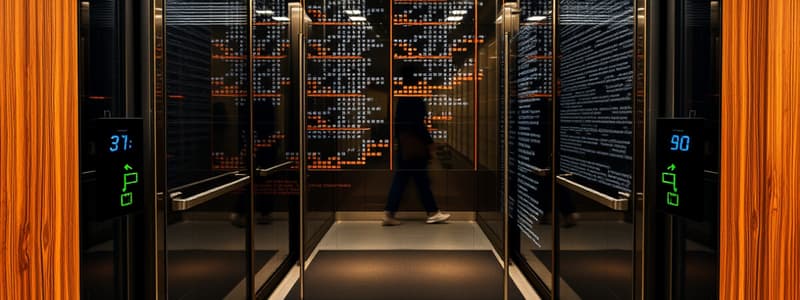Podcast
Questions and Answers
What is the primary function of an I/O scheduler?
What is the primary function of an I/O scheduler?
- To configure the operating system settings
- To optimize the order of I/O requests (correct)
- To manage system memory allocation
- To increase the rotational speed of disks
The First-Come First-Served I/O scheduling algorithm processes requests based on their arrival order.
The First-Come First-Served I/O scheduling algorithm processes requests based on their arrival order.
True (A)
Name one algorithm that I/O schedulers can use to optimize performance.
Name one algorithm that I/O schedulers can use to optimize performance.
Shortest Seek First
The _____ is the device that includes the read/write heads and tracks data on the disk.
The _____ is the device that includes the read/write heads and tracks data on the disk.
Match the I/O scheduling algorithms with their characteristics:
Match the I/O scheduling algorithms with their characteristics:
Which factor does not affect the transfer time of data from a disk sector?
Which factor does not affect the transfer time of data from a disk sector?
Optimizing I/O operations can lead to increased access latency for processes.
Optimizing I/O operations can lead to increased access latency for processes.
What are the two factors that determine the transfer time from a disk sector to the controller?
What are the two factors that determine the transfer time from a disk sector to the controller?
The operating system can increase I/O performance by optimizing _____ requests.
The operating system can increase I/O performance by optimizing _____ requests.
Which of the following algorithms does not focus primarily on reducing seek time?
Which of the following algorithms does not focus primarily on reducing seek time?
Which of the following is NOT a method to perform an I/O operation?
Which of the following is NOT a method to perform an I/O operation?
With programmed I/O, the CPU actively waits for device operations to complete before proceeding.
With programmed I/O, the CPU actively waits for device operations to complete before proceeding.
What does the printf() function do to reduce the number of I/O operations?
What does the printf() function do to reduce the number of I/O operations?
In programmed I/O, the CPU reads from and writes to the device's __________.
In programmed I/O, the CPU reads from and writes to the device's __________.
Match the I/O method with its description:
Match the I/O method with its description:
What principle does the Elevator Algorithm in I/O scheduling follow?
What principle does the Elevator Algorithm in I/O scheduling follow?
The SCAN algorithm is known to require more head movements than the Shortest Seek First (SSF) algorithm in most cases.
The SCAN algorithm is known to require more head movements than the Shortest Seek First (SSF) algorithm in most cases.
What is the maximum seek time for the SCAN algorithm?
What is the maximum seek time for the SCAN algorithm?
The SCAN algorithm is also known as the ______ algorithm.
The SCAN algorithm is also known as the ______ algorithm.
Match the following I/O scheduling strategies with their characteristics:
Match the following I/O scheduling strategies with their characteristics:
Which of the following is a downside of the SCAN algorithm?
Which of the following is a downside of the SCAN algorithm?
In the Elevator Algorithm, the I/O scheduler may serve requests outside its current direction before changing directions.
In the Elevator Algorithm, the I/O scheduler may serve requests outside its current direction before changing directions.
What is the main goal of the I/O Scheduler using the Elevator Algorithm?
What is the main goal of the I/O Scheduler using the Elevator Algorithm?
When using the SCAN algorithm, the I/O head changes direction after reaching the ______.
When using the SCAN algorithm, the I/O head changes direction after reaching the ______.
How many cylinder changes are required for the given example if the head starts at position X with 10 requests?
How many cylinder changes are required for the given example if the head starts at position X with 10 requests?
What does the Budget Fair Queueing (BFQ) I/O scheduler in Linux primarily aim to optimize?
What does the Budget Fair Queueing (BFQ) I/O scheduler in Linux primarily aim to optimize?
Windows prior to Vista preferred critical I/O operations over others without distinction.
Windows prior to Vista preferred critical I/O operations over others without distinction.
What is the primary purpose of error correcting codes (ECC) in hard drives?
What is the primary purpose of error correcting codes (ECC) in hard drives?
Which algorithm allows the head to jump back to the nearest request after reaching the last request?
Which algorithm allows the head to jump back to the nearest request after reaching the last request?
Logical Block Addressing exposes the actual physical topology to the operating system.
Logical Block Addressing exposes the actual physical topology to the operating system.
Mac OS X (at least until version ______) has no I/O scheduler.
Mac OS X (at least until version ______) has no I/O scheduler.
What is the primary function of an I/O scheduler in operating systems?
What is the primary function of an I/O scheduler in operating systems?
Match the following operating systems with their I/O scheduling characteristics:
Match the following operating systems with their I/O scheduling characteristics:
Which I/O scheduling method utilizes priority levels for processing I/O requests in Windows since version 7?
Which I/O scheduling method utilizes priority levels for processing I/O requests in Windows since version 7?
In the ______ algorithm, the head moves from the first to the last cylinder before changing direction.
In the ______ algorithm, the head moves from the first to the last cylinder before changing direction.
The concept of fairness in I/O scheduling means that all processes receive an equal amount of bandwidth.
The concept of fairness in I/O scheduling means that all processes receive an equal amount of bandwidth.
Match the I/O scheduling algorithms with their descriptions:
Match the I/O scheduling algorithms with their descriptions:
What might happen to I/O requests in systems without sophisticated schedulers?
What might happen to I/O requests in systems without sophisticated schedulers?
Which of the following statements is true regarding modern disk controllers?
Which of the following statements is true regarding modern disk controllers?
The ______ controller in a disk system might reorder requests after being sorted by latency.
The ______ controller in a disk system might reorder requests after being sorted by latency.
First-Come, First-Served (FCFS) is an I/O scheduling strategy that optimizes seek times.
First-Come, First-Served (FCFS) is an I/O scheduling strategy that optimizes seek times.
What are the two main metrics that software-based I/O schedulers can prioritize?
What are the two main metrics that software-based I/O schedulers can prioritize?
What is one of the primary benefits of using error correcting codes in hard drives?
What is one of the primary benefits of using error correcting codes in hard drives?
Flashcards are hidden until you start studying
Study Notes
I/O Scheduler: Elevator Algorithm Variants
- SCAN: Head moves from the first to the last cylinder; changes direction after reaching the end.
- LOOK: Similar to SCAN, but changes direction immediately if no requests are present in the current direction.
- C-SCAN: Services requests from the first to the last track, then jumps back to the first track to continue serving.
- C-LOOK: Once reaching the last request, the head jumps back directly to the lowest request without scanning the entire track.
I/O Scheduling and Logical Block Addressing
- Knowledge of hard drive topology is crucial for effective I/O scheduling.
- Logical Block Addressing (LBA) can obscure the physical topology, complicating scheduling.
- Modern disks often manage I/O scheduling internally through the disk controller, which understands the physical layout.
- The OS may implement First-Come First-Served (FCFS) or maintain its own I/O scheduling for fairness, regardless of hardware optimizations.
General Principles of I/O Scheduling
- I/O schedulers reorder requests to improve performance and reduce access latency.
- Common scheduling algorithms include:
- First-Come First-Served (FCFS): Serves requests in the order received.
- Shortest Seek First (SSF): Prioritizes requests closest to the current head position.
- Elevator Algorithm: Seeks to minimize movements by servicing requests in one direction until the end and then reversing.
Efficiency of the Elevator Algorithm
- Reduces head movements compared to basic methods like FCFS.
- Provides a maximum seek time of twice the number of cylinders.
- Variants exist, such as Linux's Budget Fair Queueing (BFQ) scheduler offering improved performance under certain constraints.
I/O Schedulers: Software Metrics
- Modern I/O schedulers focus on fairness and latency rather than low-level hardware metrics.
- Fairness: Ensures all processes receive appropriate I/O bandwidth without strict equality.
- Latency: Sorts requests based on their expected response times.
- Notable I/O schedulers include:
- Linux: Implements BFQ for fairness.
- Windows: Introduced priority queues since Windows 7 for critical I/O processing.
- Mac OS X: Generally lacks a dedicated I/O scheduler prior to version 10.4.
Error Correcting Codes (ECC)
- Hard drives incorporate error correcting codes to handle defects during read/write operations.
- ECC is critical for maintaining data integrity, especially in high-density storage environments.
- Systems may buffer requests to optimize I/O operations, which can impact performance due to added overhead.
I/O Methods
- Three principal methods for I/O operations include:
- Programmed I/O: CPU directly controls devices, waiting for each operation to finish before issuing the next.
- Interrupt-driven I/O: Devices signal the CPU upon readiness, alleviating busy waiting.
- DMA (Direct Memory Access) I/O: Allows devices to transfer data without continuous CPU intervention, enhancing efficiency.
Studying That Suits You
Use AI to generate personalized quizzes and flashcards to suit your learning preferences.




